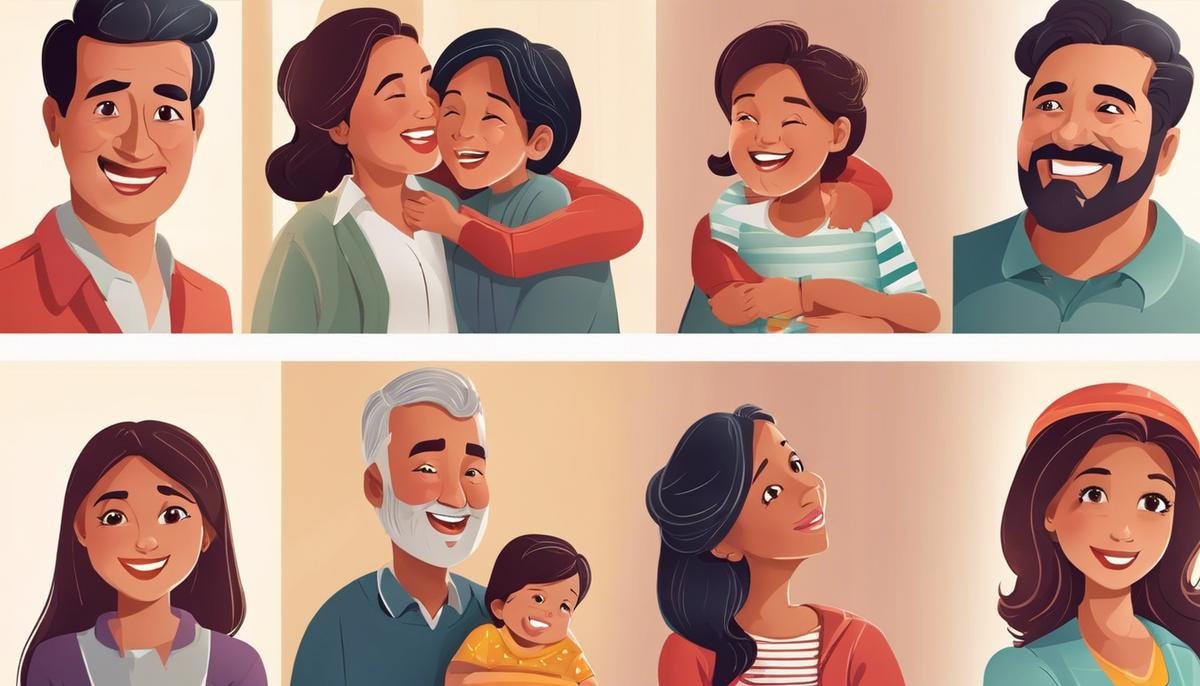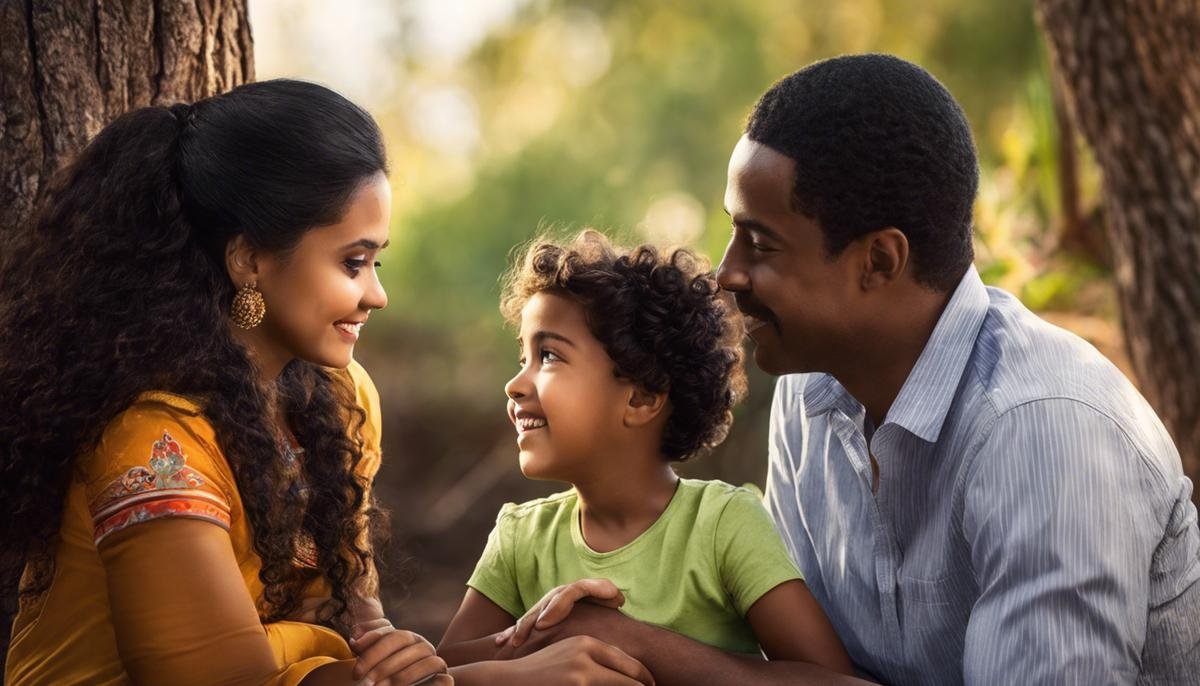
Communication extends beyond the boundaries of spoken language, with a complex tapestry of nonverbal signals playing an equally significant role. Among these, facial expressions serve as one of the most immediate and powerful forms of nonverbal communication. From a subtle shift in the gaze to the expanse of a beaming smile, these expressions can prelude the spoken word, influencing perceptions and shaping interactions. The silent dialogue written upon our faces often tells a story just as profound as the one crafted by our words, especially within the familial realm. This essay embarks on a journey to unravel the mysteries of facial expressions in the dynamics of everyday communication, offering a lens to better understand and nurture the relationships that frame our lives.
The Basics of Facial Expressions in Communication
Facial Expressions: Decoding the Silent Alphabet of Communication in Our Daily Lives
As a bustling tribe of little ones and grown-ups, we all become amateur linguists in our own right. We study, often unknowingly, the delicate dance of eyebrows, the subtle twitch of a lip, or the fleeting crinkle around the eyes. Yes, before the spoken word even has a chance to bloom, it’s the silent language of facial expressions that starts the conversation—even among the tiniest members of the family.
Think about it, from the smallest coo to the biggest belly laugh; our faces tell stories without uttering a single syllable. It’s this unspoken code that bridges the gap between diverse languages, cultures, and ages, uniting us all in an unspoken understanding—a true superpower in our toolkit for family bonding and human connection.
Each furrowed brow or twinkling eye is like the ABCs of a language that doesn’t require flashcards or bedtime story practice sessions. Infants—those sponge-like absorbers of all things life—rely exponentially on our facial cues. They’re learning the basics, what comfort looks like, what joy feels like, all through the warm security of a parent’s smile or the concerned furrowing of a brow.
But it’s not just about interpretation; facial expressions are our first foray into empathy. A child’s ability to read and respond to the emotional states of others begins with that facial dialogue. It’s right there at the family dinner table, where frowns can speak louder than a stern voice or smirks can spread infectious giggles faster than the common cold. Each micro-expression is like a note passed in the classroom of our day-to-day interactions, quietly building a narrative of shared understanding.
Facial expressions not only convey emotions but also intentions. Between squabbling siblings, a raised eyebrow can be the silent referee reminding them of fairness, or a shared smirk between parents can become a secret code of solidarity during a hectic family outing.
Moreover, the subtleties of facial communication are part of the magic tapestry of relationships. As we peel back the layers of the heart through smiles, winks, and nods, we find ourselves nurturing the roots of trust and companionship that anchor our families through the stormiest of weather.
Let’s also not forget our role as models for the ever-watchful eyes of our kids. The gentle lines around our eyes when we smile authentically can teach more about kindness and sincerity than the most well-crafted lesson plan. It’s our day-to-day interactions, the way we communicate love, patience, and sometimes disappointment through our expressions, that shapes the emotional intelligence of our little ones.
In a digital age where screens often mediate our interactions, cherishing the silent power of our in-person exchanges becomes all the more vital. It’s these nuanced, wordless connections that enrich our daily communication, echoing the ancient rhythms of a language that surpasses time—a language written in the arch of an eyebrow, the curve of a lip, the glow of the eyes. It’s unmistakable, indispensable, and beautifully universal.
So the next time we’re all together, whether it’s a noisy family game night or the quiet moments before the pitter-patter of little feet settle into slumber, pay homage to the ABCs of our facial expressions. Let’s trust that in this gaze and in that grin, we’re not just communicating but truly connecting with our loved ones, sowing the seeds of understanding and love that will flourish for generations to come.

Decoding Your Child’s Facial Cues
Delving deeper into the world of unwritten words and unvoiced emotions, it becomes evident that the art of decoding a child’s silent expressions hinges on a combination of intuition, observation, and heart. Children, especially youngsters who are yet to master the art of articulation, speak volumes with the furrow of a brow, the curvature of a lip, or the sparkle in an eye. For the perceptive parent, these nuances are a gateway to a child’s inner world.
To truly unravel the mysteries that dance across a child’s face, engaging in the subtle art of ‘face reading’ becomes an invaluable tool. This isn’t about mind-reading or guesswork but involves informed and gentle interpretation. Watch keenly when a small frown accompanies concentration during play. It’s a non-verbal cue signaling deep engagement or perhaps minor frustration. When lips purse or twitch, it might speak of uncertain thoughts trying to find their place.
The dynamism in children’s eyes alone can reveal universes about their unspoken feelings. Bright, wide eyes often shout excitement or curiosity, whereas a quick eye roll might be a tween’s silent rebellion. It’s crucial to respect these signs and address them with sensitivity.
Often overlooked, body language and posture tag along with facial expressions. Observe how a child’s physical openness or closed-off stance mirrors their emotional state. A slumped posture and downward gaze might be a signifier of sadness or disappointment.
As a static smile doesn’t always mean happiness, neither does a frown invariably signal sadness. One must be cautious not to jump to conclusions. A child frowning while drawing may simply be focusing intently, not experiencing negative emotions. Context is king in interpreting these signals accurately.
Fostering an environment where children feel comfortable expressing their emotions supports the healthy development of their emotional vocabulary. Simple, consistent questions about their day and feelings cultivate a practice of sharing. This, in turn, makes it easier to connect facial expressions with specific emotions or thoughts.
Avoiding over-interpretation is also key. Sometimes, a child’s facial expression is just a fleeting moment that doesn’t warrant deep analysis or a probing question. Respecting a child’s space and allowing them to process their own emotions is a cornerstone of trust.
Ultimately, understanding a child’s unspoken feelings is a compassionate dance, a balance between insightful observation and providing the space to let those feelings be freely expressed. In nurturing this silent dialogue, the bond grows, affirming that beyond spoken language, we are deeply connected in the unspoken realms of the heart.

The Impact of Parents’ Expressions on Child Development
Delving deeper into the impact of parental facial expressions, it’s essential to recognize their influence on a child’s self-esteem and confidence. Parents often forget that their simple non-verbal cues can either uplift or dampen a child’s spirit. When a parent beams with pride over an accomplishment, no matter how small, it instills a sense of achievement and motivates the child to strive for more. Meanwhile, an unimpressed or dismissive expression could inadvertently communicate doubt or disapproval, potentially stifling a child’s willingness to take risks or try new things.
Facial expressions also play a crucial role in emotional regulation. Children closely watch how their parents handle emotions; do they see a calm demeanor in the face of frustration, or do eyebrows furrow and lips tighten? As emotional blueprints, parents’ expressions teach kids, by example, how to manage and express their feelings healthily. It’s about showing that it’s alright to feel a certain way and even better to understand and express these emotions appropriately.
Conflict resolution is yet another domain where expressions are pivotal. Constructive facial feedback during disagreements teaches children to approach conflicts with a mindset geared towards resolution rather than escalation. The softening of the eyes, a tilt of the head, and even a gentle smile can go a long way in showing a child that it’s possible to disagree without the need for angst or anger.
It’s important to note that authenticity is key. Kids are exceptionally sharp at picking up incongruences between what is said and what is shown; a parent saying “I’m listening” while their face is buried in a phone screen sends mixed messages. Ensuring that facial expressions match verbal communications reinforces trust and helps children feel valued and understood.
Mimicry, although subconscious, is a fascinating aspect of children mirroring the facial expressions they see at home. This mimicry is not just mimicry for the sake of it; it is a learning tool. Through this, children learn the social and emotional language that will carry them throughout life.
The balance of guidance and freedom in emotional expression is a dance; parents lead with their expressions, providing cues, and children follow, finding their rhythm and style. Encouragement through a warm smile or a nod can give children the confidence to express themselves more freely while still offering a safety net of guidance.
In conclusion, facial expressions are immensely powerful in shaping a child’s emotional landscape. From bolstering self-esteem to teaching emotional management and resolution skills, a parent’s face can be a child’s compass in the vast sea of emotions. As keepers of this unspoken dialogue, it’s a beautiful responsibility to ensure that the expressions children read daily are those of love, understanding, and encouragement. In doing so, the foundation is laid for emotional growth that is robust, resilient, and rich with the understanding that although words are powerful, the stories told through expressions are equally profound.

Facial Expressions and Family Bonding
Hey there, fellow parents and family-focused folks! Let’s talk about those magical moments of shared smiles and looks within our family—the silent conversations that knit our hearts closer together. They say a picture is worth a thousand words, but let’s not forget that a single shared glance or a smile can be just as priceless when it comes to our loved ones.
From the gentle raise of an eyebrow that says “I believe in you” to the twinkle in the eye that whispers “I understand,” these small yet potent gestures can reinforce the sense of security and belonging that every family craves.
Let’s explore how shared smiles and looks, those non-verbal nuggets of gold, can fortify that incredible family bond. Where words might fail, a warm, knowing look can fill in the blanks, speaking right to the heart.
When a child nails something they’ve been working on, whether it’s acing a math test or finally riding without training wheels, catching a parent’s proud smile is more powerful than the loudest cheers. This spark of silent encouragement can become a cornerstone for a child’s self-esteem. It’s like saying, “You did that, and I couldn’t be prouder,” without uttering a single syllable.
Now, consider the silent language of comfort. When thunder rumbles and little faces frown with fear, a soft smile from a parent can be the soothing balm that banishes nightmares. It’s the unspoken promise that they’re safe, that everything’s going to be all right. These are the expressions that become the memories cherished far into adulthood.
Shared laughter, too, is a glue that holds families together. Ever caught a sibling’s eye across the dinner table, sharing a secret chuckle over an inside joke? How about those shared winks when everyone’s in on the fun? These are the stitches in the quilt of family life, creating warmth and unity.
Even in times of conflict, a compassionate look can go a long way. A furrowed brow softened by understanding, or a tight-lipped frown turned upside down in forgiveness, can de-escalate emotions and lead the way to peaceful resolution.
Let’s not forget to mention shared looks of amazement and awe: the collective jaw-drops at the sight of a shooting star, or holds its breath at the first glimpse of the ocean on a family trip. These experiences, wordlessly shared, are imprinted in our hearts and serve to remind us of our shared journey through life.
In an age where digital screens often replace faces, intentionally engaging in these non-verbal exchanges is more crucial than ever. The investment we make in shared smiles and looks pays dividends in the emotional well-being and interconnectedness of our family.
Behind every shared look and smile is the building block of trust and intimacy that normalizes showing affection and support. In the ebb and flow of daily life, these glances form a silent symphony that attests to the love and understanding shared within the walls of a home.
From the heartfelt gaze that lingers a second longer than necessary to communicate “I love you” to the sideways glance that says “We’ll get through this together,” we’re constantly telling our family story without words. And it’s in these quiet moments that the family bond is not just strengthened, but also celebrated.
Remember, the next time your child looks up from a drawing or your partner glances your way, that these shared smiles and looks are your unspoken family language, the one that speaks directly to the soul. Here’s to cherishing these glances, for they are the silent affirmations of our love, the steady pillars that uphold the home we’ve built together.

Navigating Misunderstandings with Facial Expressions
When a child’s frown lingers longer than usual, it speaks volumes about their inner world. As the unsung heroes of emotional guidance, parents have a vital role in recognizing these small, yet significant, cues. This journey of understanding often begins with the recognition of how powerful shared smiles and looks within family relationships can be.
Embrace the silent language of non-verbal communication to tighten family bonds. A knowing glance can communicate complex emotions and understanding without a need for words. When children struggle to articulate their feelings, silent encouragement and support through a warm smile can be immensely comforting.
Acknowledge the profound impact of non-verbal gestures that reassure and comfort. A gentle touch or a hug can be as loud as any verbal reassurance when children are distressed. These actions are the threads that weave the tapestry of a loving and secure family life.
Harness the joy of shared laughter and inside jokes to create lasting memories and unity. Laughter is a universal connector; it is contagious and an instant magnet for family members to rally around each other. Celebrate the silly moments and the quiet triumphs with laughter—it’s a natural stress reliever and a booster for togetherness.
Recognize that silent expressions play a crucial role during conflicts. An empathetic nod or a pause before reacting can make a world of difference. These non-verbal cues are critical for teaching children about patience and the power of calm in resolving disagreements.
Cherish silent moments of awe and wonder; they are precious in a busy, talkative world. These pockets of shared silence are often the moments where families connect on a deeper level, whether it’s gazing at a majestic sunset or watching a plant bloom. These experiences form an invisible bond that deepens family connections.
Contend with the digital era’s challenge on non-verbal communication. With the omnipresence of screens, it’s increasingly important to consciously carve out time for unplugged communication. Engage in screen-free time to ensure that the digital divide doesn’t erode the silent but profound way families speak to each other without words.
Foster trust and intimacy through the power of shared glances. Eyes can be windows into one’s soul, and what a privilege it is to communicate so intimately with your loved ones. A look can convey trust, understanding, and shared secrets, fostering an irreplaceable closeness between family members.
Last of all, appreciate the unspoken love and affirmation that is the foundation of familial love. These silent signals of affection confirm that words are only a fraction of the conversation within a family. The power of a supportive nod, the strength in a committed handshake, the security in a holding hand—these are the unspoken declarations of love that resonate through time.
Embrace the simplicity and depth of non-verbal communication; it is an art of its own, equally powerful as the spoken word. Families that master this silent dance of understanding and empathy are bound to enjoy a rich and harmonious relationship, cultivating an atmosphere where every frown, smile, and subtle gesture is understood and valued, providing children with a safe haven to grow and flourish emotionally.

As the nuances of facial expressions unravel before our eyes, we are reminded of the silent yet potent language that operates alongside our verbal exchanges. It is a language that conveys empathy, love, and understanding, binding families in an invisible web of emotional connectivity. Embracing this unspoken dialogue has the power to enrich our interactions, bridge gaps of misunderstanding, and foster a familial atmosphere rooted in emotional attunement. Armed with the knowledge of how our faces can speak volumes, we step forward into a world where every glance, smile, or frown is an opportunity to connect, teach, and grow together, reinforcing the sentiment that, in the end, our faces might very well be the mirrors of our hearts to one another.




